Ayanar Horses, Chettinad, Tamil Nadu
Tamil Nadu - Part One
1991, 1994, 1998, 2005, 2011, 2013, 1018, 2022
The Pilgrim Trail
Tamil Nadu sees relatively few tourists outside of the domestic travel market. And the vast majority of non- Indian tourists stick to the main hubs of Chennai & Mahabalipuram, Pondicherry, Madurai, and possibly Tanjore. Yet Tamil Nadu is an extensive State, with a plethora of interesting places, cultural, religious, architectural, and scenic.
The domestic tourist scene is well established, with a particular influx during the December & January pilgrimage season, so travel & accommodation are relatively simple. Note that unlike some places, the pilgrim season here is an excellent time to travel – temples & towns are brimming with life and colour, and it is largely self contained (pilgrims will hire their own buses for example) so it doesn’t cause problems booking places to stay or onward travel.
This post basically goes from south to north in terms of the places mentioned. All are worth a visit, though I’ll split many of the places into more detailed posts.
Kanyakumari
Kanyakumari is right at the southern tip of the country, and home to Kumari, the goddess responsible for protecting India from the south. It also has a surprisingly large & vigorous Christian population, especially in the fishing community.
Imagine a seaside holiday town, crossed with religious & cultural significance & sights, together with a fishing port, and you have some idea of the flavour. From auspicious bathing, to Gandhi memorials and fairy floss it’s got something for everyone.
Suchindram
A short distance north is Suchindram. Unusually for Tamil Nadu both the gopurams and main structure of the Thanumalayam Temple are painted white, with a religiously derived wash of crushed shells and Ayurvedic plants. Just to really confuse non Hindus the main deity is a combination of all three major Hindu gods. Shirt off Temple for men.
Tiruchendur
Tiruchendur is probably the trickiest temple to get to that I’ll mention, but one of the absolute best. A genuine shore temple, right on the beach, that even includes, if you’re willing to pay the ‘special Darshan’ price to a priest outside, an underground chamber beneath the main altar. One of the Nine Abodes of Lord Murugan, a shirt off temple for men.
Rameswaram
One of the geographical cardinal points of Hinduism, and therefore a major year round pilgrimage town. Maybe because of this I found Rameswaram to be a bit of a dump & overrated as a destination- the town is on an island connected by a grid locked road & rail bridge- but essentially survives on a constant turnover of short term visitors, with the grasping commercialism and impatience that implies on all sides – both visitors and locals.
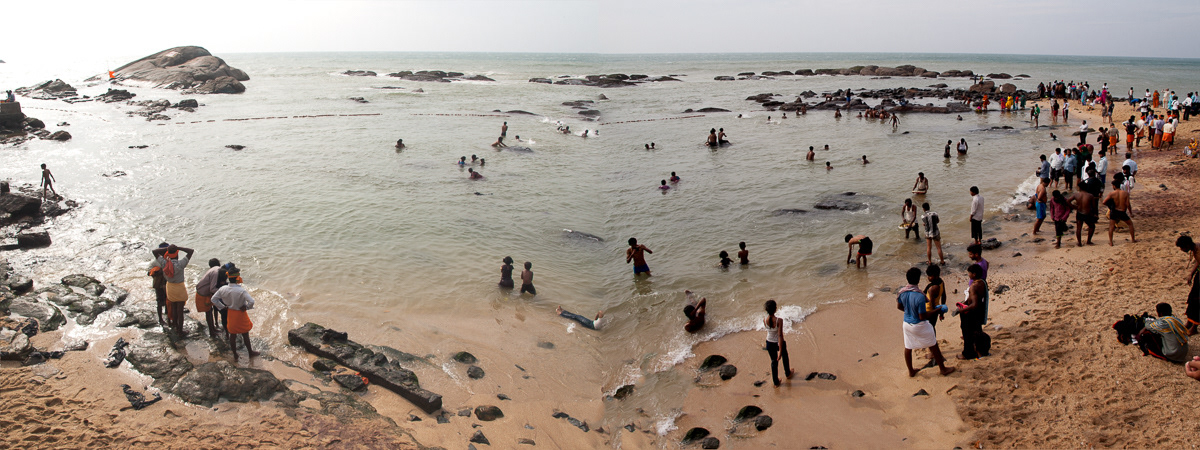
Kanyakumari

Tiruchendur

Tiruchendur

Rameswaram
Madurai
Madurai is most famous for the Shree Menakshi Temple in the heart of this booming city. An unmissable first point of call, it can overshadow some other excellent places to see, particularly around the outskirts of this city. These include the Solai Malai Mandapam Murugan temple, along a mountaintop scenic drive up in the surrounding hills. The Thirupparankundram Murugan temple, with a Nayak era gopuram leading into an amazing carved out temple interior dating back to Pandyas (pre 1000 CE). While in town the Koodal Azhagar temple is a Vishnu counterpart to Menakshi, and offers a smaller but fascinating mix of sights.
Chettinad
Chettinad is an area two hours drive to the northeast of Madurai. It consists of a group of small towns and villages, and is the traditional home of the Chettiyar caste. From the mid 19th century Chettiyars were a a key element in the Indian diaspora throughout the British empire, often working as bankers & local financiers. Maintaining strong connections to their ancestral towns & villages, the consequences was a fascinating blend of influences, particularly in terms of architecture and food. Materials, foods, and styles were imported and exported, as various Chettiyar clans competed in status displays of buildings & hospitality.
Chettinad is also a centre for the worship of Ayyanar. Ayyanar is the representation of a pre-Hindu, indigenous deity. Depicted as black skinned, moustachioed, and mounted on a horse, Ayyanar worship was once widespread across Tamil Nadu, but today is easiest to find in the form of statues and shrines around Chettinad.
Tanjore (Thanjavur)
Tanjore is a famous for the Brihadisvara Temple, one of the three World Heritage great living Chola temples. A former princely state, it also has a royal palace, and a recent history as a university town.
Kumbakonam
Kumbakonam is rightfully known as a temple town. Popular with Indian tourists, it is off the beaten path as far as most foreign visitors are concerned. This is despite it being home to two of the three Great Living Chola temples. One of these is in town, the other a few kilometres outside town. The third Great Chola temple is in Tanjore.
Kumbakonam also has a host of historically & architecturally important temples within the city limits, which continue to function as centres for Shiva & Vishnu worship. There is a sacred tank, in the heart of downtown, which is one of the most important in South India. And, if you want more, Kumbakonam is at the centre of a group of astrological temples, representing the Indian zodiac, which make up their own domestic pilgrimage circuit. While few of these are architecturally or artistically important, visiting a few of them is a fascinating glimpse into another aspect of Indian spiritual life.

Pilgrims, Kumbakonam

Thanjavur

Thanjavur

Kumbakonam

Kumbakonam

Kumbakonam

Madurai

Kumbakonam

Madurai

Madurai

Thanjavur
Trichy (Tirichupallai)
Trichy is a small cross roads city in the centre of Tamil Nadu. On the banks of the Kavery River, it’s a commercial hub, with good transport connections, and the site of one of the largest temple complexes in India, on the island of Srirangam. The Sri Ranganathswamy Temple is the largest, with multiple concentric compounds, and which still retains the traditional commercial lined entrances. The Rock Fort sits in town atop a towering crag, studded with temples dating from the Pandyas to the later Nayaks. Lots of steps to climb but panoramic views.
Pondicherry
Pondicherry is a break from the temple trail. Unless you count a couple of significant Franco-Indian cathedrals and churches. It’s Hindu temples are nothing to write home about, but Pondy offers some excellent accommodation, a different range of food, and a welcome relief from the restrictive Tamil Nadu licensing laws. It’s actually a city that seems to have improved over the years, settling into its identity. Should you get bored with the often fusion style cuisine, very good though some of it is, and the walkable footpaths of French Pondicherry, you can always cross the ditch / creek into the Indian part of town where Tamil Nadu reasserts it’s identity.
Chidambaram
Chidambaram is famous for the wonderfully atmospheric temple of Shiva as Nataraj – the dancing Shiva. Run by a private foundation it is reportedly one of the wealthiest temples in the South, and is a both a major pilgrimage point, and a riot of colour, movement & ceremony inside.
The town itself is small and scruffy. That impression could be exacerbated by the fact that things always seem to stuff up whenever I’ve visited – riots, curfews, all night power outages in rooms with windows encrusted shut by dead insects. The first time I ever hired a car & driver in India was to flee Chidambaram after riots, with public transportation shut down for two days. Even the most recent visit, when we decided to avoid staying overnight & just drop in en route, led to repeat encounters with the pushiest, most inappropriately behaved, touching & grabbing, beggar I’ve met in years. The town fascinates me, but you’ve been warned.
Mahabalipuram
Twenty five years ago Mahabalipuram was a charming small village where you were awakened by the tink tink noise of stonecutters chisels. Situated on the coast a couple of hours drive south of Chennai it is home to a cluster of key early monuments; the Shore Temple, the relief sculpture of Arjuna’s Penance, carved into the rock monoliths on the inland side of town, and a series of cave & freestanding temples, including the Five Rathas. It is also home to the annual Mahabalipuram Dance Festival.
Even ten years ago Mahabalipuram had charm. Nowadays though it is swamped by the conjunction of backpacker/ flashpacker ghettos, Indian resort tourism, and day trippers from Chennai. The Dance Festival, spread over several days in January, used to be an atmospheric and moving event showcasing South Indian dance for connoisseurs and interested tourists, held beside one of the temples in town. Now it’s held on a scruffy wasteland by the Shore Temple, with all the charm of a kitsch sound and light show. I get that everything changes, and this is not meant as a “You should have been there when….” rant – there are very few places I’ve returned to that aren’t still worthwhile, albeit sometimes in very different ways, - but Mahabalipuram seems to have handled the influx of modern tourism particularly poorly. In short, unless you’re really pushed for time & in Chennai, I’d say skip Mahabalipuram for any of a plethora of more worthwhile options in Tamil Nadu.
Kanchipuram
Kanchipuram is a town a couple of hours west of Chennai. Famous as an ancient centre of Hinduism, with temples and sights scattered throughout, it is also renowned as a centre of silk weaving. The temples range from historic monuments to active temples with a thriving ceremonial presence. Kanchipuram is also a relatively rare centre in Tamil Nadu for Vishnu temples, rather than Shiva or Murugan.
It’s an easy town to navigate, with dozens of worthwhile temples & monuments, good food and accommodation options. The silk showrooms are used to tourists from all over India & abroad, hard to resist, but there’s always the obligatory free chai, even if you’re just window shopping.
Chennai
Chennai is the booming capital of Tamil Nadu, an international gateway, and tricky to avoid. Though it is possible to do an airport run from Mahabalipuram. There are worthwhile remnants of old Madras, and plenty of cultural aspects to see. Thinking of Chennai as a bunch of largely self contained neighbourhoods can help when deciding where to base yourself – but it’s not a walkable city between each neighbourhood.

Puducherry

Kanchipuram

Mahabalipuram

Sri Ranganathswamy Temple, Trichy

Chidambaram
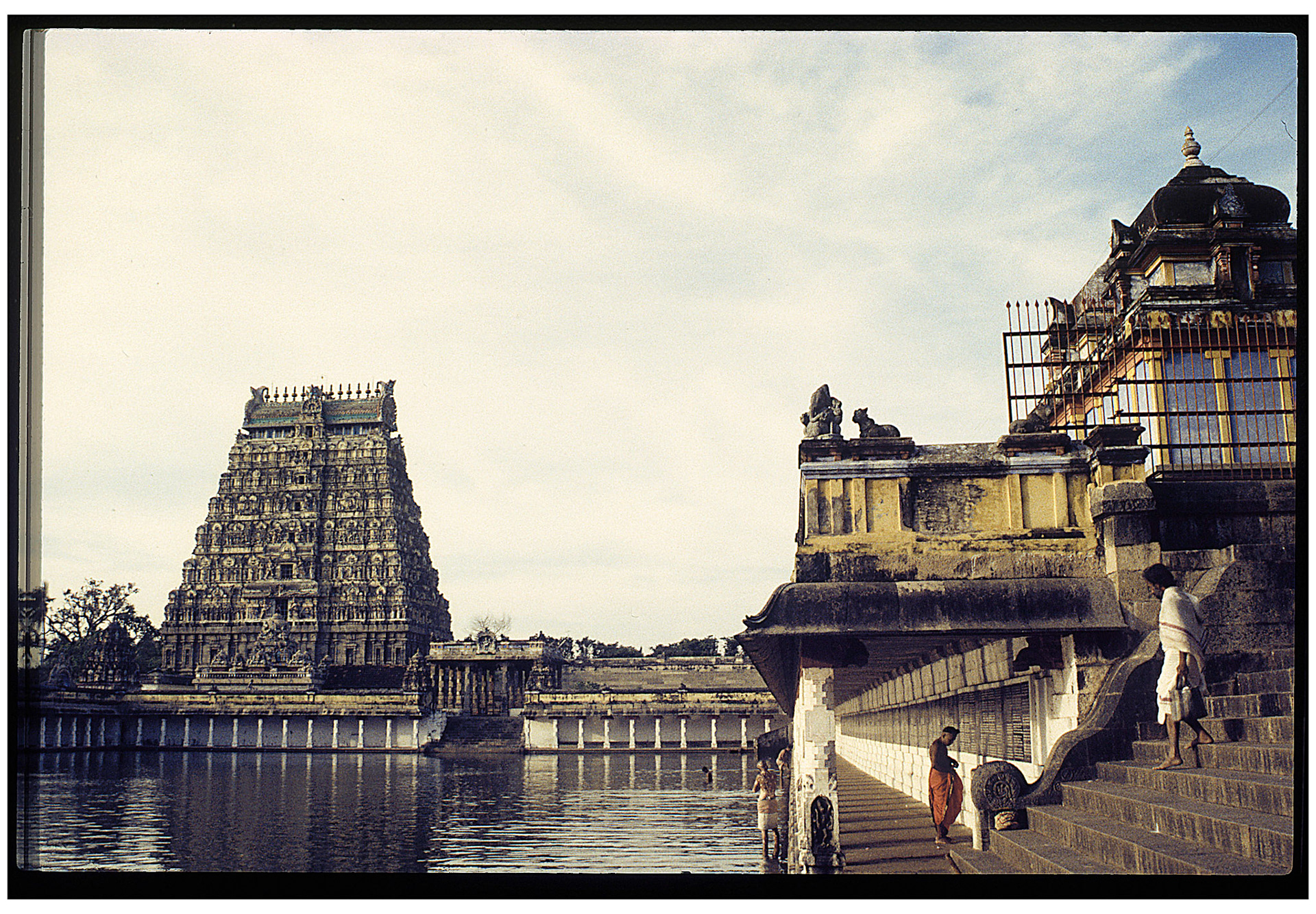
Chidambaram

Sri Ranganathswamy Temple, Trichy

Chidambaram

Sri Ranganathswamy Temple, Trichy
Tamil Nadu Part Two
Madurai
Madurai is most famous for the Shree Meenakshi Temple in the heart of this booming city. An unmissable first point of call, it can overshadow some other excellent places to see, particularly around the outskirts of this city. Once a provincial city, albeit with a very long history, Madurai is still a provincial city at heart, but increasingly bursting with traffic and construction.
The Shree Meenakshi Temple is at the heart of Madurai. It’s four enormous gopurams tower over the surrounding area. Shree Meenakshi, the ‘fish-eyed’ goddess is the partner deity to Lord Shiva in a temple that runs to the clock of daily ceremonies. There are puja ceremonies six times a day, three in the morning, and three in the evening, culminating in the 9.00 (or 9.30) pm ceremony when Lord Shiva is carried to the bedchamber of Shree Meenakshi.
Constructed between the mid 1200’s to 1600’s, inside is a bit of labyrinth of shrines, a tank, and processional pathways. It is not just the elaborately decorated interiors that are of interest – the enormous temple kitchens do a roaring lunch trade, and against one outer wall are a series of cow stalls. The temple is closed in the afternoons. These days there is a complex security procedure to enter, with wire cages, metal detectors, and a no camera policy (which seems to include smart phones).
Tirumalai Nayak Palace, about a kilometre from Shree Meenakshi Temple, is usually mentioned as the other must see in Madurai. Personally, I have my doubts – there are other places of more interest.
Koodal Azhagar Temple. Not far from the Shree Meenakshi Temple is this temple, in some ways a Vishnu counterpart. Possibly predating the the Shree Meenakshi Temple, it is of Pandya origins with Nayak additions & renovations. A much smaller temple, it is still worth a visit, with some excellent carvings, a fine collection of small temple carts, and a more intimate sense of human interactions.
Outside and around Madurai are some real highlights, which can be combined on an easy half day tour. Remember most temples & sights shut in the afternoon, so a full day is not value.
Thirupparankundram Murugan temple. This wonderful temple has a Nayak era gopuram leading into a temple interior carved into the side of an enormous rock monolith. Dating back to the Pandyas (pre 1000 CE), enormous ‘god doors’ separate the two sections. One of the six abodes of Lord Murugan, this temple celebrates his marriage, so there are many shrines with a female focus. A very busy temple in pilgrim season, it may be worth paying a guide to help in skipping the longest of the queues. Eight kms out of town, this rock monolith also has a Jain Cave Temple carved into it on the other side, and a shrine to a Sufi saint near the top.
Another nearby sight, easily combined, is the Solai Malai Mandapam Murugan Temple, a mountaintop temple reached by a scenic drive up in the Alagar hills surrounding Madurai. The temple itself is nothing special, but a welcome green relief from the traffic & dust of the city. On the same road is the Alagar Kovil, a Vishnu Temple, again of significant age, which itself is surrounded by the vestiges of an even larger temple complex. these two temples are about 25 kms from Madurai
For a more contemporary cultural & architectural treat, the Heritage Madurai Hotel is a gem of Asian modernism. Geoffrey Bawa, the great Sri Lankan architect, designed the reception area in 1970. His assistants & followers continued to refurbish the old British textile managers bungalows in this extensive low rise, and green, compound. A charming & relaxing place to stay, where you can actually put Bawa’s principles of indoor & outdoor tropical living to the test, especially if you spring for one of the villas with a private plunge pool.
Madurai Nuts & bolts
Transport. Madurai sits at the hub of transport networks across Tamil nadu and beyond. There is an airport for domestic flights. Train connections are solid, east to Chennai, south to Kanyakumari, west to Trivandrum or Kochi, or various points north. The Tamil Nadu hill stations are another option. Out-station car hire is fairly straightforward, with hotels or travel agents used to organising this. Autos are easy to catch around town, though the traffic can be pretty bad. The area immediately around the Shree Meenakshi Temple is pedestrian only.
Accommodation & food. Accommodation options are many & varied, with the main decision being the area you want to stay. Apart from the Heritage Hotel, mentioned above there is another colonial style resort a bit further out on the hills overlooking town. Or a number of reasonable options a short walk to the west from the Shree Meenakshi Temple. Food choices are equally widespread, from long running local establishments to well cooked pan Indian food. As a temple town though, alcohol can be harder to come across outside the fancier hotels.

Koodal Azhagar Temple, Madurai

Thirupparankundram Murugan Temple, Madurai

Shree Manakshi Temple, 1994

Thirupparankundram Murugan Temple, Madurai

Shree Manakshi Temple, Madurai

Thirupparankundram Murugan Temple, Madurai
Kanyakumari
Kanyakumari is right at the southern tip of the country, and home to Kumari, the goddess responsible for protecting India from the south. It also has a surprisingly large & vigorous Christian population, especially in the fishing community.
Imagine a seaside holiday town, crossed with religious & cultural significance & sights, together with a fishing port, and you have some idea of the flavour. From auspicious bathing, to Gandhi memorials and fairy floss it’s got something for everyone.
Most places are easily walkable. The tip at Cape Cormorin is the scene for bathing, within a sheltered rocky inlet. En route is a fairground, offering souvenirs, horse rides – worth watching to see tourists pretend to be Maratha warriors – and cheap clothing. New clothes are actually a traditional adjunct to an Indian holiday or pilgrimage. You can also get your name inscribed on a grain of rice, or a holy stamp put on your arm. Sidewalk tattooists are available for the hardcore.
On the eastern side are the Kumari Temple, and the ferries for Vikendra Rock, with it’s enormous Thiruvellar statue. Be warned that in peak season the ferry queues are already 50 metres long by 6.30 am, half a kilometre long by midday. and the ferries may not run in rough weather. Up to 10,500 people visit the Rock a day at holiday time, so I wouldn’t exactly call it a must see.
Further north is the Cathedral of Our Lady Of The Ransom, with it’s own 4 metre tall temple car for processions in the large facing square. Small shrines are dotted around, particularly for St Anthony, the patron saint of fishermen, and for St Lucy, recognisable by holding her eyeballs on a plate. The small side streets and lanes toward the water are well worth wandering through.
Nuts & bolts
As a holiday & pilgrimage town accommodation is plentiful. Nothing particularly stylish, and don’t set expectations too high for luxury, but perfectly acceptable. Many hotels have rooftops for viewing the sunrise – you might as well get up to do this as half the hotel will be doing the same thing, before going back to bed. Noise from beachfront DJ’s – Christian & secular - may be an issue during the day and evening, but staying in town is preferable for the people watching, which is one of the highlights of Kanyamakuri.
Food is equally easily available, and decent without being outstanding. There tends to be a lot of pan-Indian menus on offer for the domestic tourists, but sticking to roughly South Indian food is probably a better bet. Alcohol is available in a few bars, invariably in the Tamil Nadu style of enclosed (& possibly underground), but beer is cold, service good, and you’re more likely to suffer from an overdose of kitsch (think lava lamp ceiling tiles) than sleaze.
Transport connections are solid – the main station is out of town but on many major train routes to Kerala, Mumbai or further north in Tamil Nadu. Most long distance train routes don’t run every day, so check schedules. The nearest airport is in Kerala in Trivandrum; prepaid taxis are a standard option from the airport. There are car hire options from travel agents in town for out station travel eg. Tiruchendur & Rameswaram.

Kanyakumari

Kanyakumari

Kanyakumari

Kanyakumari

Kanyakumari

Kanyakumari
Tiruchendur
Probably the trickiest temple to get to that I’ll mention, but one of the absolute best. A genuine shore temple, right on the beach, that even includes an underground chamber beneath the main altar.
Late afternoon sees the perambulation of a god around the outside of the temple, accompanied by music and chanting. The temple kitchens in the outer compound do a roaring trade. Peacocks wander the extensive grounds. There are odd little side shrines aplenty, such as the section of rock decorated with offerings regarding children & childbirth. Payment of ‘special Darshan’ prices will allow you to skip the queue, and the accompanying priest may take you down to the underground altar. Note; this is not for the claustrophobic, indeed the whole temple during pilgrim season is a heaving mass of people, chanting, singing, pushing, between the queue railings. Shirt off temple for men.
Tiruchendur is one of the six abodes of Lord Murugan, all in Tamil Nadu. Murugan is sometimes regarded as the other son of Siva and Parvati, sometimes seen as having had six mothers, and therefore sometimes shown with six heads. The god of war, Murugan worship was once widespread across India,but is now focused on the Tamil region, and places with a significant Tamil diaspora. His accompanying creature / vehicle is a peacock.
Nuts & bolts
Accommodation choices are limited. There is a TTDC hotel with the usual pluses & minuses; on the plus side there’s a bar that serves cold beer, and ‘only in India’ bar snacks such as breakfast cereal and bowls of fresh cooked peas. The minus side is what you’d expect of a back blocks government run hotel. A bonus is a busy and top notch South Indian restaurant between the TTDC and the temple serving the usual breakfast, lunch & dinner options. The all you can eat thalis are very good.
Transport. Tiruchendur is on the south eastern coast about half way between Kanyamakuri & Rameswaram. There is a train line, but most sevices are the very slow passenger trains, with a possible express service to & from Chennai. Buses are possible, but many domestic tourists are booked on return services or group hired coaches. So driving is really the only flexible option. The road from the south is poor, the roads north are much faster. Supposedly day trips by car are possible from Tirunelveli, which has a much wider range of accommodation choices.

Tiruchendur
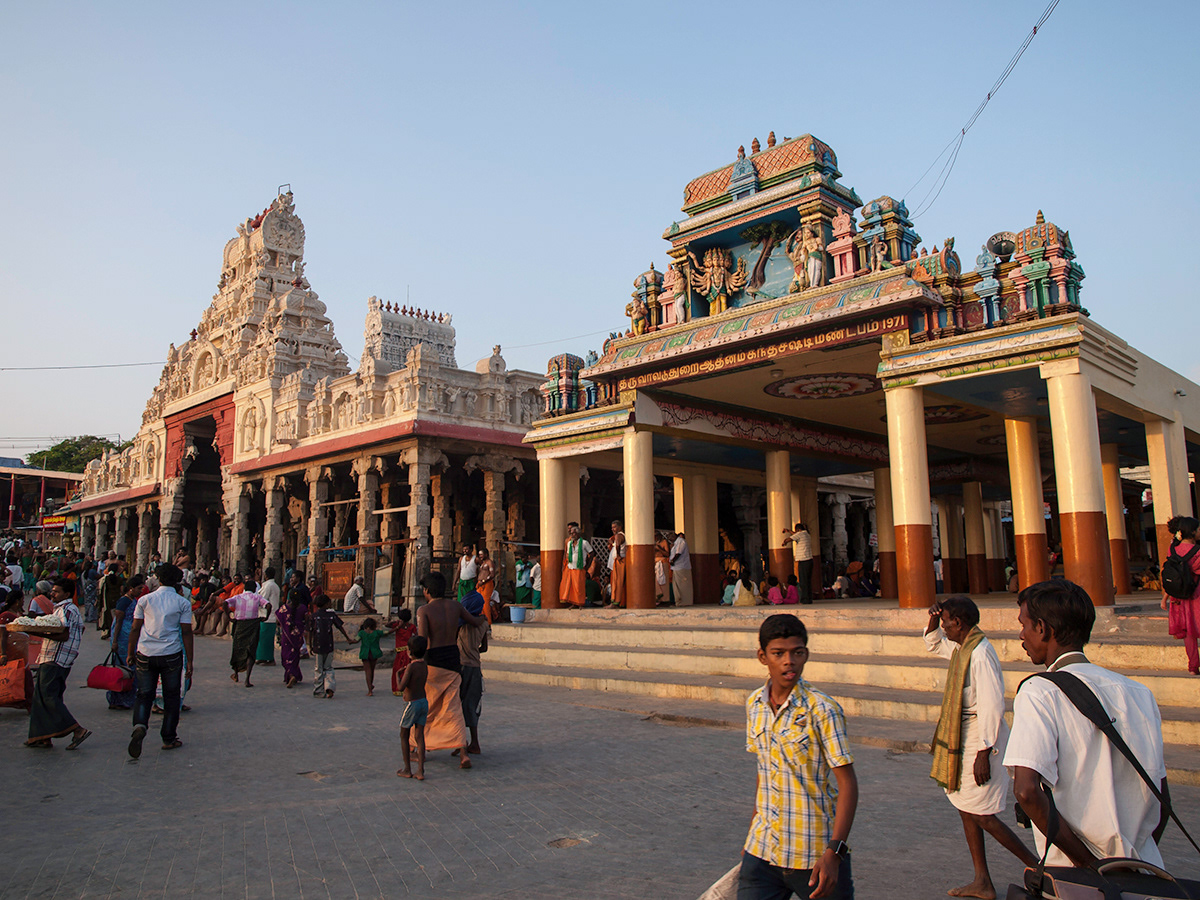
Tiruchendur

Tiruchendur
Chettinad
Apart from the series of small towns containing Chettiyar mansions, with their intricate facades, and even more elaborate interiors, the Chettinad region has some more hidden gems. The Chettiyars were organised on a clan structure and each built their own temples which, although not as imposing on the outside as some Tamil Nadu temples, contain stunning interiors. There are also Ayyannar shrines dotted throughout, with their lines of terra cotta horses. One of the only major temples featuring Ganesha as the main deity, rather than merely in a support role, is also found in Chettinad, the Karpaka Vinayakar Temple at Pillayarpatti. The Kundrakudi Murugan Temple, perched on a rocky hillock, and dating from the 12th century is also worth a stop for it's sculptures and ornate paintings. Also tucked away in the Chettinad area is the Sathyagiri Natha Perumal Temple at Thirumayam, parts of which date back to the Pandyas in the 9th century, including a very large, magnificent, rock-cut sculpture of Vishnu reclining on the waves.

Chettinad Tank

Chettinad

Chettinad

Chettinad Market

Ayanar Shrine, Chettinad

Ayanar Shrine, Chettinad

Ayanar Shrine, Chettinad

Temple Interior, Chettinad

Chettinad

Chettinad

Chettinad

Chettinad

Kundrakudi Murugan Temple, Chettinad

Sathyagiri Natha Perumal Temple, Chettinad

Sathyagiri Natha Perumal Temple, Chettinad

Temple Interior, Chettinad

Ayanar Shrine, Chettinad
Tanjore - Thanjavur
Tanjore is a famous for the Brihadisvara Temple, one of the three World Heritage great living Chola temples. A former princely state, it also has a royal palace, and a recent history as a university town.
The Brihadisvara Temple is an amazing site, and is usually packed with both pilgrims & tourists. Despite this, I’ve found Tanjore to be rather shambolic, over 20 or so years of visiting. The palace itself is unkempt, and the towns infrastructure away from the Chola temple continues to seem one step away from falling apart. The university town aspect though can lead to some interesting and engaging interactions with locals, who are passionate about Tanjore.
The Brihadisvara Temple, dating to 1010 CE, is the main point of a visit to Tanjore. Signposted around town as ‘The Big Temple”, it is as much visited as an active religious site, as it is a cultural & architectural monument. With later additions in the Nayak period (16th & 17th CE), it covers an impressive area, and is one of the exemplars of South Indian Temple design. Surrounded by Gopurams, and once a moat, within it’s walled enclosure it also contains numerous subsidiary shrines. A giant nandi faces the main temple entrance. Some Chola era murals are visible in parts.
As a former princely state Tanjore has it’s own Royal palace & associated buildings. Renovation of this complex is claimed to have occurred periodically, but over 25 years I’ve seen little evidence – it remains a mix of decreptitude & bad new additions. Still, if you’re in Tanjore the former audience hall The Darbar Mahal, is worth a look. The large onsite souvenir & handicraft emporium however is a must for any lovers of kitsch -even by Indian standards the plastic gods, saddhus, 3D pictures, and more are over the top.
Nuts & bolts
Tanjore is relatively simple to get to. Plenty of major trains pass through, though not all at convenient times. It’s a relatively short distance by road to Trichy, Madurai, or Pondicherry, with the latter offering interesting stops along the way.
There is a range of decent accommodation – the Hotel Gnanam serves good lunchtime thalis, non-veg in the evening & after 7.00 pm, beer!! For breakfast get a local or auto driver to locate the Coffee Palace – a Tanjore insitution that’s like stepping back in time, with wood fired stoves pouring out streams of pongall, dosai, idli, puris, to eat in old fashioned, blue & green painted canteen splendour, or as constant stream of take-aways. Recommended. Recently a couple of boutique hotels in restored mansions have opened

Thanjavur

Thanjavur, 1994

Brihadisvara Temple, Thanjavur

Thanjavur

Thanjavur
Kumbakonam
Kumbakonam is rightfully known as a temple town. Popular with Indian tourists, it is off the beaten path as far as most foreign visitors are concerned. This is despite it being home to two of the three Great Living Chola temples. One of these is in town, the other a few kilometres outside town. The third Great Chola temple is in Tanjore.
Kumbakonam also has a host of historically & architecturally important temples within the city limits, which continue to function as centres for Shiva & Vishnu worship. There is a sacred tank, in the heart of downtown, which is one of the most important in South India. And, if you want more, Kumbakonam is at the centre of a group of astrological temples, representing the Indian zodiac, which make up their own domestic pilgrimage circuit. While few of these are architecturally or artistically important, visiting a few of them is a fascinating glimpse into another aspect of Indian spiritual life.
Two of the three World Heritage listed Great Living Chola Temples – Gangaikonda Cholapuram Temple (1035 CE) and Airevatesvara Temple (1166 CE) are in and near Kumbakonam. Both are maintained by the IAS, and undergoing progressive restoration works, while continuing to function as centres of worship, though not as popularly as the Chola temple at Tanjore. Both temples actually have finer and more resolved carving & decoration than Tanjore, with the smallest temple, Airevatesvara being the most detailed. Airevatesvara is just outside the main town of Kumbakonam, Gangaikonda is 35 odd kilometres away.
Temples in Kumbakonam.
Various websites will list up to 100 odd or more important temples in Kumbakonam itself. This in a relatively small city / large town. Many date back to the Chola era, with the usual later additions. Others date to the Nayak era (1600’s CE) with their typical exuberant interior carvings and pillars. Unusually for Tamil Nadu many temples are dedicated to Vishnu rather than Shiva. Particularly noteworthy are; Sarangapani Temple, a Vishnaite temple approached through a still functioning covered market, complete with a temple elephant, and Adi Kumbeswarar Temple, a large Shaivite temple with both Chola and Nayak elements.
Mahamaham Tank is a particularly sacred tank in Kumbakonam. One of the largest tanks in Tamil Nadu, it is the focus of festivals annually, in February/ March, and every twelve years, when the tank may be flooded with a million devotees. At any time of the year pilgrims will be visiting the tank, and it’s surrounding temples and wells.
Navagraha (9 planet temples). Surrounding Kumbakonam at various distances are nine temples representing the 9 planets of Hindu cosmology. This is a popular pilgrimage for domestic tourists, with maps available in town at hotels. Many of these structures are relatively small, but were originally constructed during the Chola period with later additions. Well worthwhile visiting some, perhaps in combination with a trip to Airevatesvara Temple, for a different and intimate snapshot of religious life.
Nuts & bolts
Kumbakonam seems short of accommodation options that rise above adequate. Staying in town is a better option given the easy access, walking or by auto to the various sights. Foodwise, it’s worth noting that Kumbakonam is the home of the wonderful flaky paratha, a close relation to the Malaysian roti. There are some very good eating options – a modern friendly South Indian joint for breakfasts, and evening snacks such as uttapams, dosai, vadai, etc & excellent South Indian coffee. There’s a biryani joint that’s popular with businessmen, families (and take-aways). Various chai & coffee street stalls set up with snacks in the late afternoon. Alcohol is not readily available – one option would have to be the sleaziest & most unfriendly grog stop I’ve encountered in India, & I’ve drunk in quite a few.

Airevatesvara Temple, Kumbakonam

Venus Temple, Kumbakonam

Tank, Kumbakonam

Temple Float, Kumbakonam
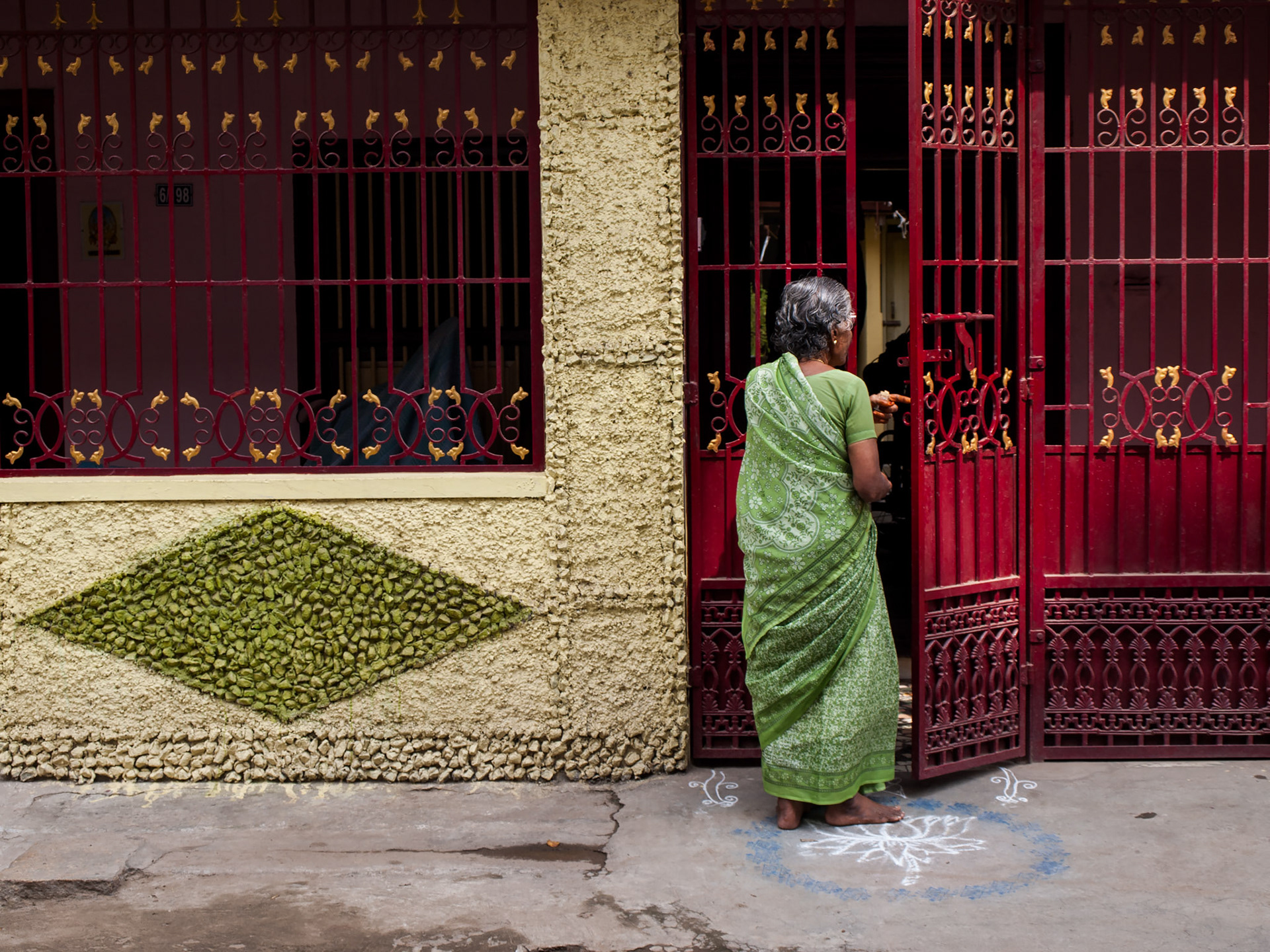
Kumbakonam

Airevatesvara Temple

Astrological Temple, Kumbakonam

Airevatesvara Temple

Airevatesvara Temple
Kanchipuram
Some of the oldest temples in India can be found in Kanchipuram, as well as a host of additions constructed over the centuries of Kanchipurams' base as a religious centre. The Kailasanathar Temple dates from around 700 CE, with ornate sculptures in niches in the surrounding walls. The Vaikunta Perumal Temple is a similar age, with perhaps less elaborate surviving decoration but functioning much more actively as a temple. There's also that relative rarity, a significant shakti temple, dedicated to female divinity, the Kamakshi Amman Temple. If you feel like a change from what can at times in Tamil Nadu be a preponderance of Shiva & Murugan temples, Kailasanathar Temple, Kanchipuram is a major Vishnu temple, surrounded by satellite temples.

Kanchipuram

Varadharaja Perumal Temple, Kanchipuram, Kanchipuram

Kanchipuram

Kanchipuram

Kanchipuram

Kanchipuram

Kanchipuram

Vaikunta Perumal Temple, Kanchipuram
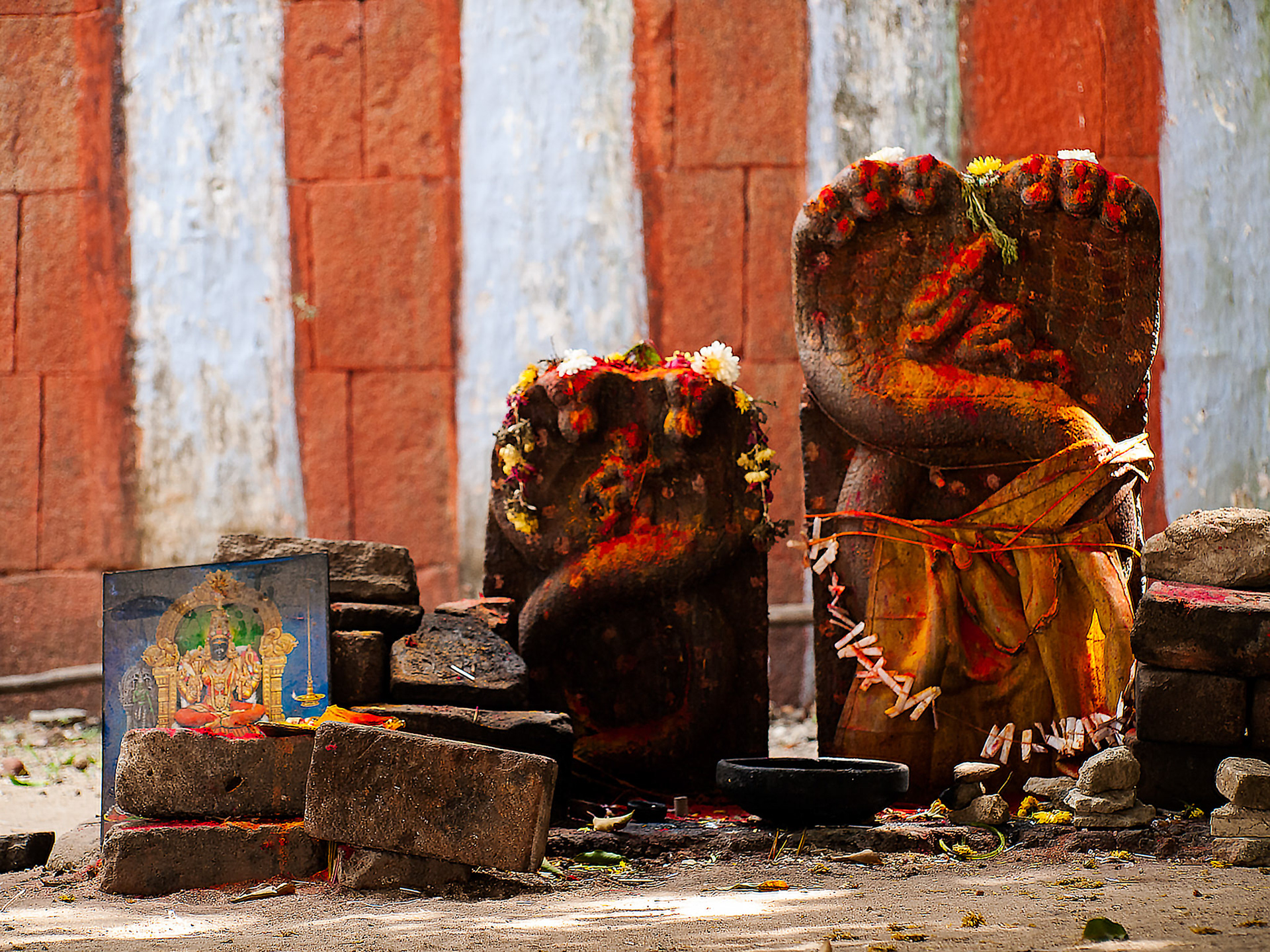
Kanchipuram

Kailasanathar Temple, Kanchipuram

Kailasanathar Temple, Kanchipuram

Kailasanathar Temple, Kanchipuram

Varadharaja Perumal Temple, Kanchipuram, Kanchipuram
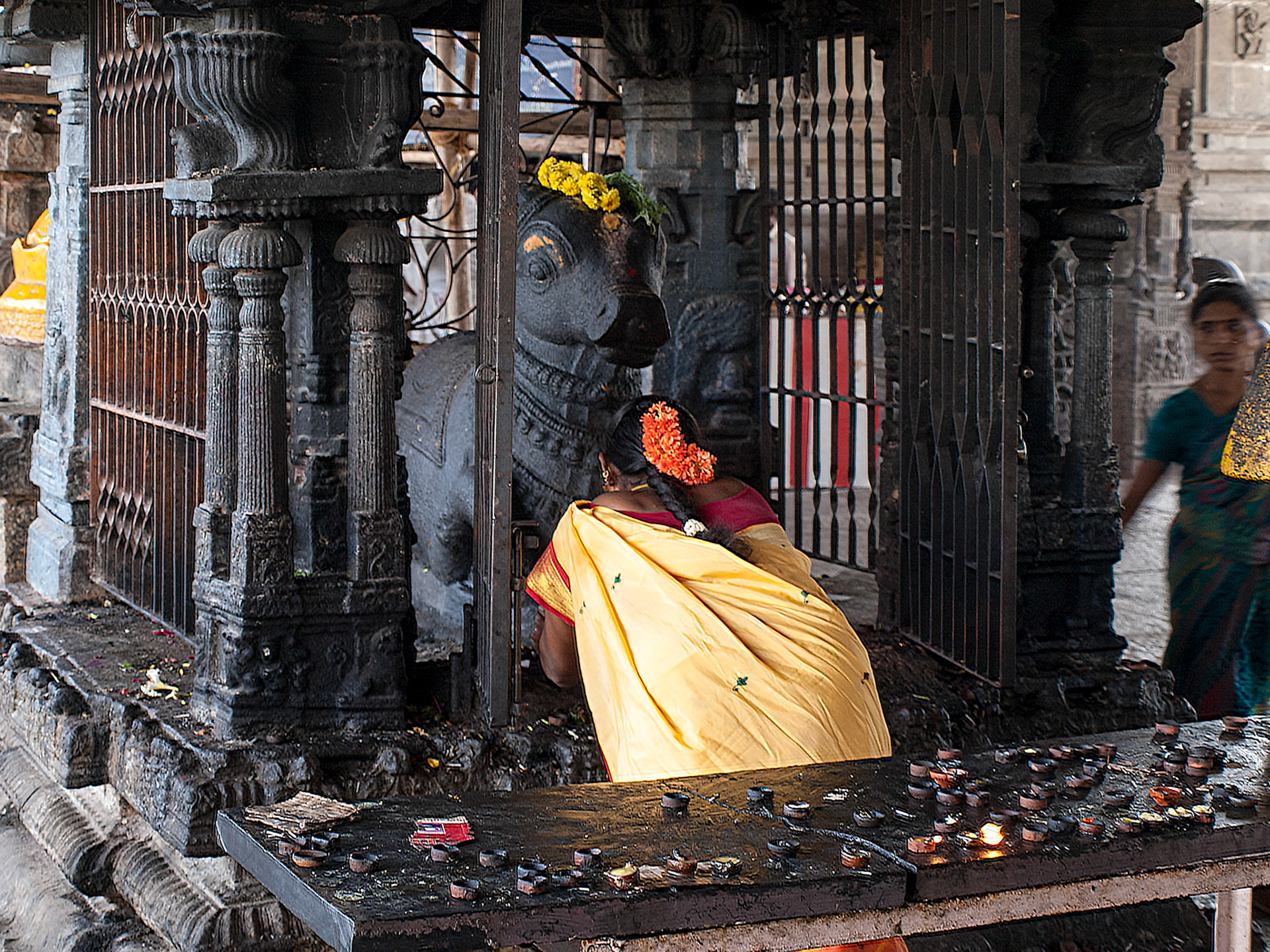
Kanchipuram

Kanchipuram

Varadharaja Perumal Temple, Kanchipuram
Mahabalipuram

Mahabalipuram, 1998

Mahabalipuram, 1994

Mahabalipuram, 1994

Mahabalipuram, 1994

5 Rathas, Mahabalipuram, 1994

Main Street, Mahabalipuram, 1994

Mahabalipuram 2015





